HONDA CR-V 2001 RD1-RD3 / 1.G Owners Manual
Manufacturer: HONDA, Model Year: 2001, Model line: CR-V, Model: HONDA CR-V 2001 RD1-RD3 / 1.GPages: 326, PDF Size: 4.58 MB
Page 231 of 326
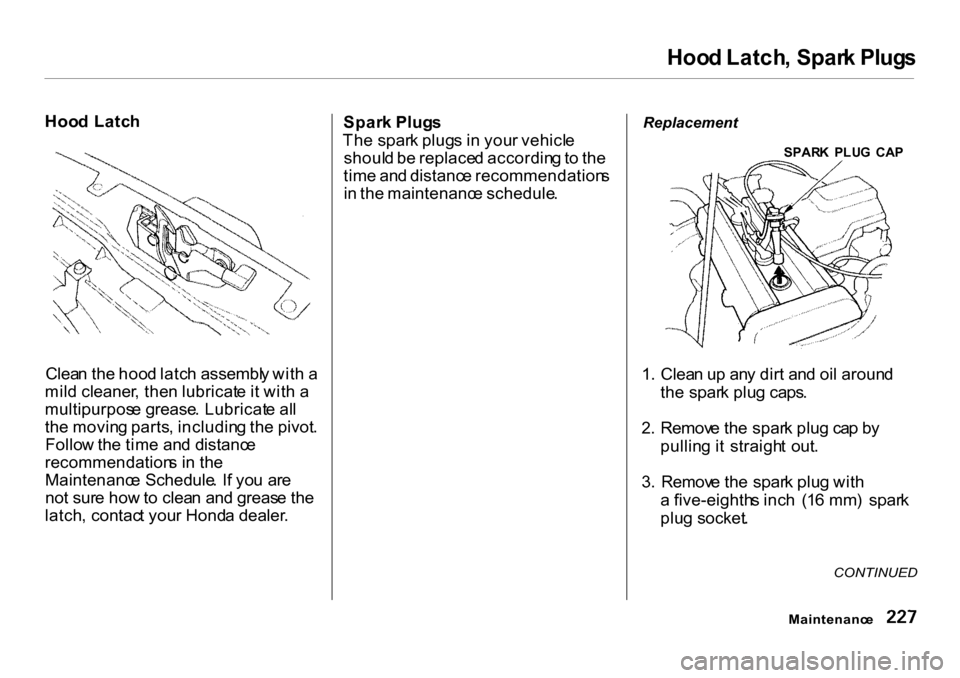
Hoo
d Latch , Spar k Plug s
Hoo d Latc h
Clea n th e hoo d latc h assembl y wit h a
mil d cleaner , the n lubricat e it wit h a
multipurpos e grease . Lubricat e al l
th e movin g parts , includin g th e pivot .
Follo w th e tim e an d distanc e
recommendation s i n th e
Maintenanc e Schedule . I f yo u ar e
no t sur e ho w to clea n an d greas e th e
latch , contac t you r Hond a dealer . Spar
k Plug s
Th e spar k plug s i n you r vehicl e
shoul d b e replace d accordin g to th e
tim e an d distanc e recommendation s
i n th e maintenanc e schedule . Replacement
SPARK PLU G CA P
1 . Clea n u p an y dir t an d oi l aroun d
th e spar k plu g caps .
2 . Remov e th e spar k plu g ca p b y
pullin g i t straigh t out .
3 . Remov e th e spar k plu g wit h
a five-eighth s inc h (1 6 mm ) spar k
plu g socket .
CONTINUED
Maintenanc e
Page 232 of 326
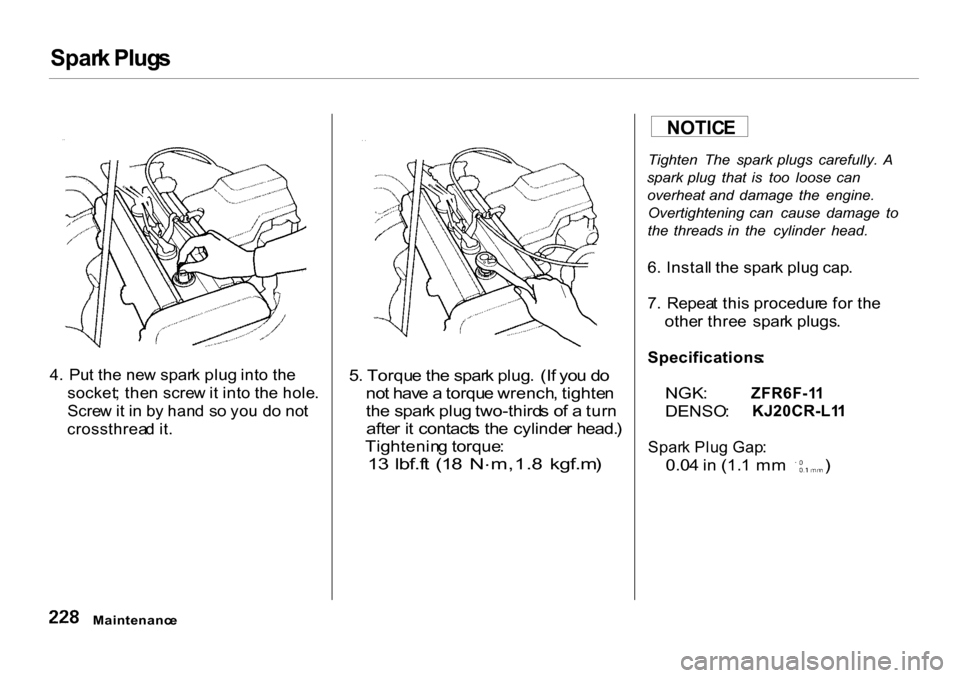
Spar
k Plug s
4 . Pu t th e ne w spar k plu g int o th e
socket ; the n scre w it int o th e hole .
Scre w it i n b y han d s o yo u d o no t
crossthrea d it .
5
. Torqu e th e spar k plug . (I f yo u d o
no t hav e a torqu e wrench , tighte n
th e spar k plu g two-third s o f a tur n
afte r i t contact s th e cylinde r head. )
Tightenin g torque :13 lbf.f t (1 8 N .
m,1. 8 kgf.m )
Tighten The
spark
plugs carefully. A
spark plug that is too loose can
overheat and damage the engine.
Overtightening can cause damage to
the threads in the cylinder head.
6 . Instal l th e spar k plu g cap .
7 . Repea t thi s procedur e fo r th e
othe r thre e spar k plugs .
Specifications :
NGK :
DENSO :
ZFR6F-1
1
KJ20CR-L1 1
Spar k Plu g Gap :
0.0 4 in (1. 1 m m )
Maintenanc e
NOTIC
E
Page 233 of 326
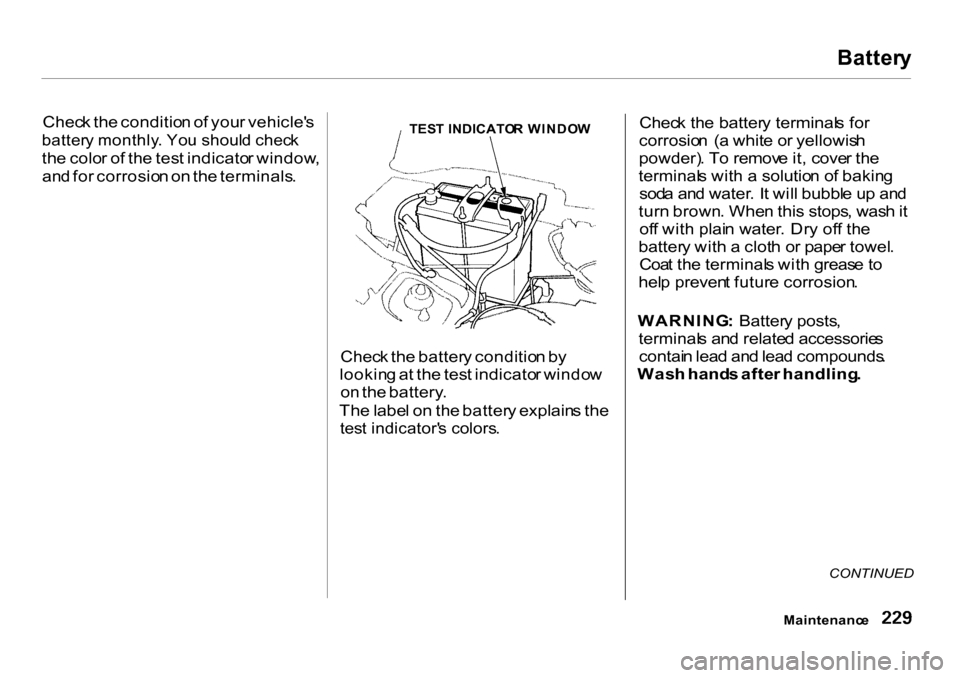
Batter
y
Chec k th e conditio n o f you r vehicle' s
batter y monthly . Yo u shoul d chec k
th e colo r o f th e tes t indicato r window ,
an d fo r corrosio n o n th e terminals .
TES
T INDICATO R WINDO W
Chec k th e batter y conditio n b y
lookin g a t th e tes t indicato r windo w
o n th e battery .
Th e labe l o n th e batter y explain s th e
tes t indicator' s colors .
Chec
k th e batter y terminal s fo r
corrosio n ( a whit e o r yellowis h
powder) . T o remov e it , cove r th e
terminal s wit h a solutio n o f bakin g
sod a an d water . I t wil l bubbl e u p an d
tur n brown . Whe n thi s stops , was h it
of f wit h plai n water . Dr y of f th e
batter y wit h a clot h o r pape r towel .
Coa t th e terminal s wit h greas e t o
hel p preven t futur e corrosion .
WARNING : Batter y posts ,
terminal s an d relate d accessorie s
contai n lea d an d lea d compounds .
Was h hand s afte r handling .
CONTINUED
Maintenanc e
Page 234 of 326
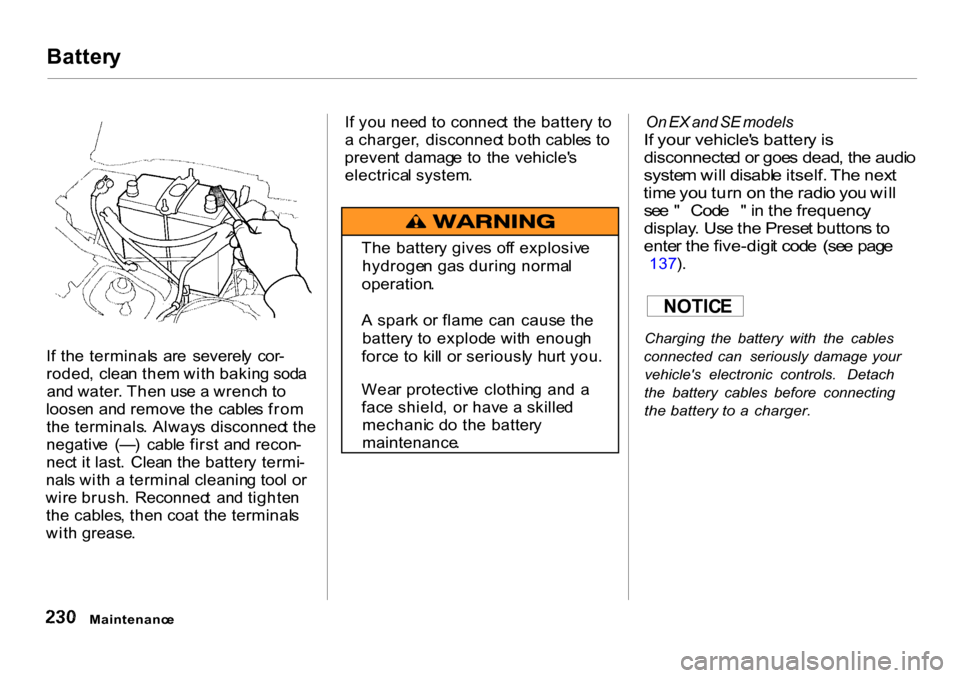
Batter
y
I f th e terminal s ar e severel y cor -
roded , clea n the m wit h bakin g sod a
an d water . The n us e a wrenc h t o
loose n an d remov e th e cable s fro m
th e terminals . Alway s disconnec t th e
negativ e (— ) cabl e firs t an d recon -
nec t i t last . Clea n th e batter y termi -
nal s wit h a termina l cleanin g too l o r
wir e brush . Reconnec t an d tighte n
th e cables , the n coat the terminal s
wit h grease . I
f yo u nee d t o connec t th e batter y t o
a charger , disconnec t bot h cable s t o
preven t damag e t o th e vehicle' s
electrica l system .
On
EX and SE models
I f you r vehicle' s batter y is
disconnecte d o r goe s dead , th e audi o
syste m wil l disabl e itself. The nex t
tim e yo u tur n o n th e radi o yo u wil l
se e " Cod e " in th e frequenc y
display . Us e th e Prese t button s to
ente r th e five-digi t cod e (se e pag e
137 ).
Charging the battery with the cables
connected can seriously damage your
vehicle's electronic controls. Detach
the battery cables before connecting
the battery to a charger.
Maintenanc e
NOTIC
E
Th
e batter y give s of f explosiv e
hydroge n ga s durin g norma l
operation .
A spar k o r flam e ca n caus e th e
batter y t o explod e wit h enoug h
forc e t o kil l o r seriousl y hur t you .
Wea r protectiv e clothin g an d a
fac e shield , o r hav e a skille d
mechani c d o th e batter y
maintenance .
Page 235 of 326
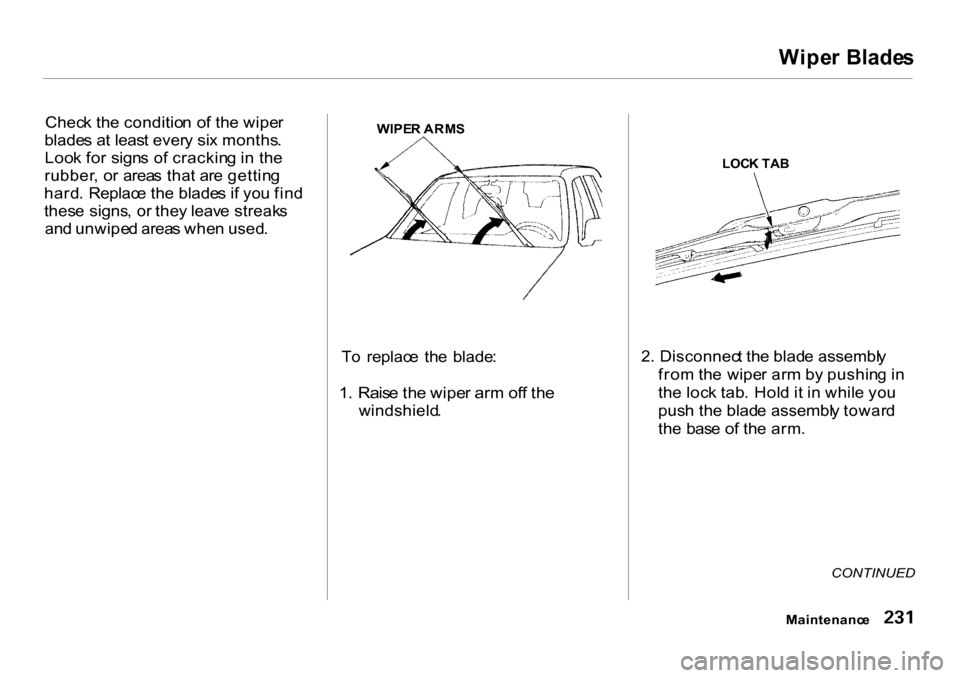
Wipe
r Blade s
Chec k th e conditio n o f th e wipe r
blade s a t leas t ever y si x months .
Loo k fo r sign s o f crackin g in th e
rubber , o r area s tha t ar e gettin g
hard . Replac e th e blade s i f yo u fin d
thes e signs , o r the y leav e streak s
an d unwipe d area s whe n used . WIPE
R ARM S
T o replac e th e blade :
1 . Rais e th e wipe r ar m of f th e
windshield .
LOC
K TA B
2 . Disconnec t th e blad e assembl y
fro m th e wipe r ar m b y pushin g in
th e loc k tab . Hol d i t i n whil e yo u
pus h th e blad e assembl y towar d
th e bas e o f th e arm .
CONTINUED
Maintenanc e
Page 236 of 326
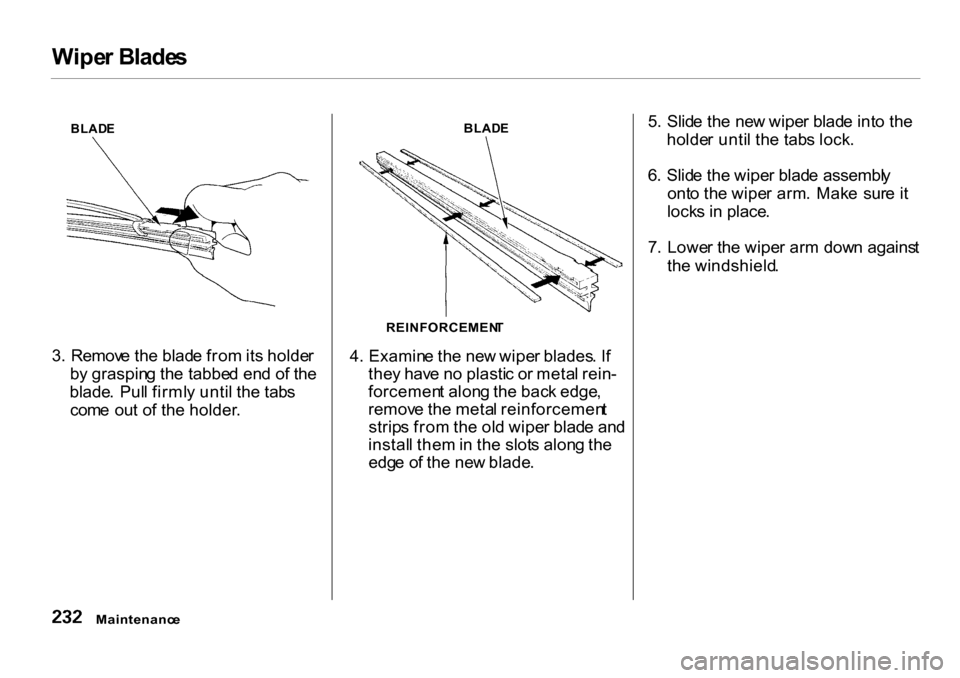
Wipe
r Blade s
BLAD E
3 . Remov e th e blad e fro m its holde r
b y graspin g th e tabbe d en d o f th e
blade . Pul l firml y unti l th e tab s
com e ou t o f th e holder . BLAD
E
4 . Examin e th e ne w wipe r blades . I f
the y hav e n o plasti c o r meta l rein -
forcemen t alon g th e bac k edge ,
remov e th e meta l reinforcemen t
strip s fro m th e ol d wipe r blad e an d
instal l the m in th e slot s alon g th e
edg e o f th e ne w blade . 5
. Slid e th e ne w wipe r blad e int o th e
holde r unti l th e tab s lock .
6 . Slid e th e wipe r blad e assembl y
ont o th e wipe r arm . Mak e sur e i t
lock s i n place .
7 . Lowe r th e wipe r ar m dow n agains t
th e windshield .
Maintenanc e
REINFORCEMEN
T
Page 237 of 326
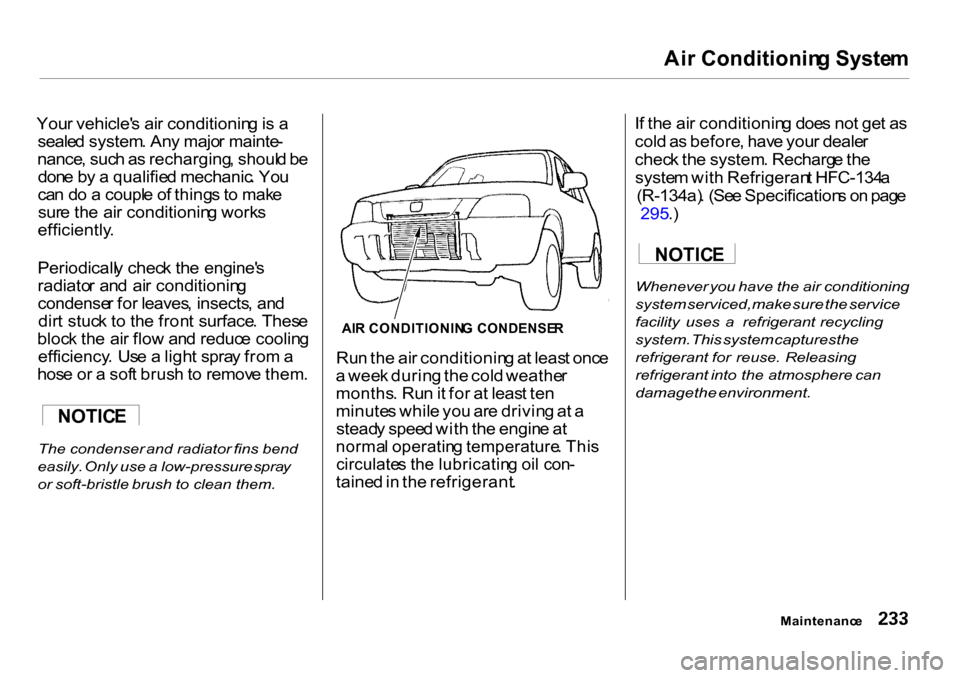
Ai
r Conditionin g Syste m
You r vehicle' s ai r conditionin g is a
seale d system . An y majo r mainte -
nance , suc h a s recharging , shoul d b e
don e b y a qualifie d mechanic . Yo u
ca n d o a coupl e o f thing s to mak e
sur e th e ai r conditionin g work s
efficiently .
Periodicall y chec k th e engine' s
radiato r an d ai r conditionin g
condense r fo r leaves , insects , an d
dir t stuc k to th e fron t surface . Thes e
bloc k th e ai r flo w an d reduc e coolin g
efficiency . Us e a ligh t spra y fro m a
hos e o r a sof t brus h to remov e them .
The condenser and radiator fins bend
easily. Only use a low-pressure spray
or soft-bristle brush to clean them.
Ru
n th e ai r conditionin g a t leas t onc e
a wee k durin g th e col d weathe r
months . Ru n it fo r a t leas t te n
minute s whil e yo u ar e drivin g a t a
stead y spee d wit h th e engin e at
norma l operatin g temperature . Thi s
circulate s th e lubricatin g oi l con -
taine d in th e refrigerant . I
f th e ai r conditionin g doe s no t ge t a s
col d a s before , hav e you r deale r
chec k th e system . Recharg e th e
syste m wit h Refrigeran t HFC-134 a
(R-134a) . (Se e Specification s o n pag e
295 .)
Whenever you have the air conditioning
system serviced, make sure the service
facility uses a refrigerant recycling
system. This system captures the
refrigerant for reuse. Releasing
refrigerant into the atmosphere can
damage the environment.
Maintenance
AI
R CONDITIONIN G CONDENSE R
NOTIC E NOTIC
E
Page 238 of 326
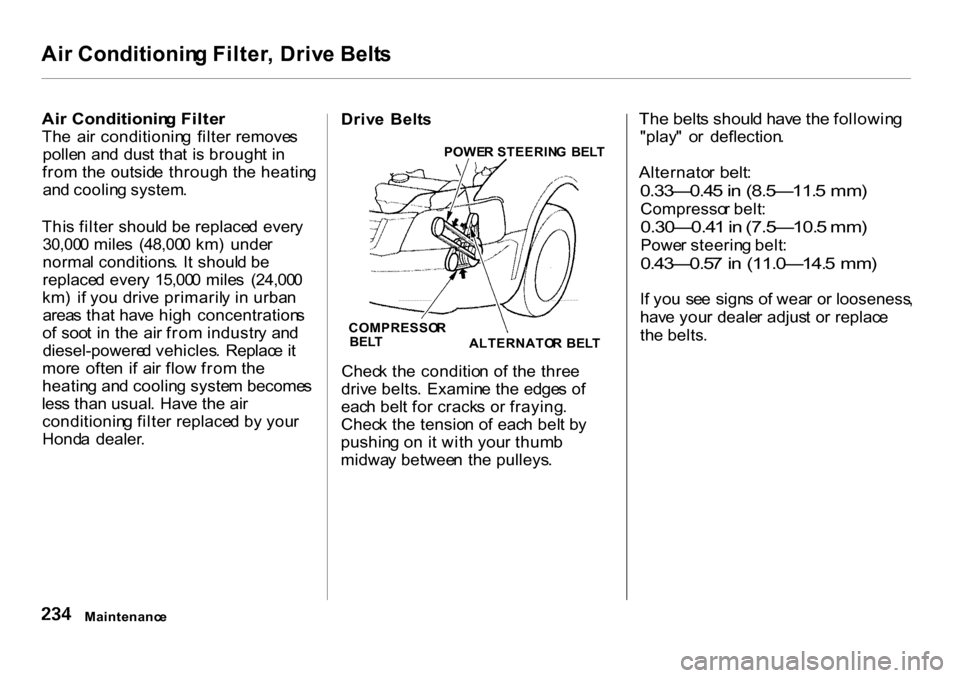
Ai
r Conditionin g Filter , Driv e Belt s
Ai r Conditionin g Filte r
Th e ai r conditionin g filte r remove s
polle n an d dus t tha t i s brough t i n
fro m th e outsid e throug h th e heatin g
an d coolin g system .
Thi s filte r shoul d b e replace d ever y
30,00 0 mile s (48,00 0 km ) unde r
norma l conditions . I t shoul d b e
replace d ever y 15,00 0 mile s (24,00 0
km ) i f yo u driv e primaril y i n urba n
area s tha t hav e hig h concentration s
o f soo t i n th e ai r fro m industr y an d
diesel-powere d vehicles . Replac e it
mor e ofte n i f ai r flo w fro m th e
heatin g an d coolin g syste m become s
les s tha n usual . Hav e th e ai r
conditionin g filte r replace d b y you r
Hond a dealer . Driv
e Belt s
Chec k th e conditio n o f th e thre e
driv e belts . Examin e th e edge s o f
eac h bel t fo r crack s o r fraying .
Chec k th e tensio n o f eac h bel t b y
pushin g o n i t wit h you r thum b
midwa y betwee n th e pulleys .
Th
e belt s shoul d hav e th e followin g
"play " o r deflection .
Alternato r belt :
0.33 —0.4 5 in (8.5 —11. 5 mm )
Compresso r belt :
0.30 —0.4 1 in (7.5 —10. 5 mm )
Powe r steerin g belt :
0.43 —0.5 7 in (11.0 —14. 5 mm )
I f yo u se e sign s o f wea r o r looseness ,
hav e you r deale r adjus t o r replac e
th e belts .
Maintenanc e POWE
R STEERIN G BEL T
COMPRESSO R
BEL T
ALTERNATOR BEL T
Page 239 of 326
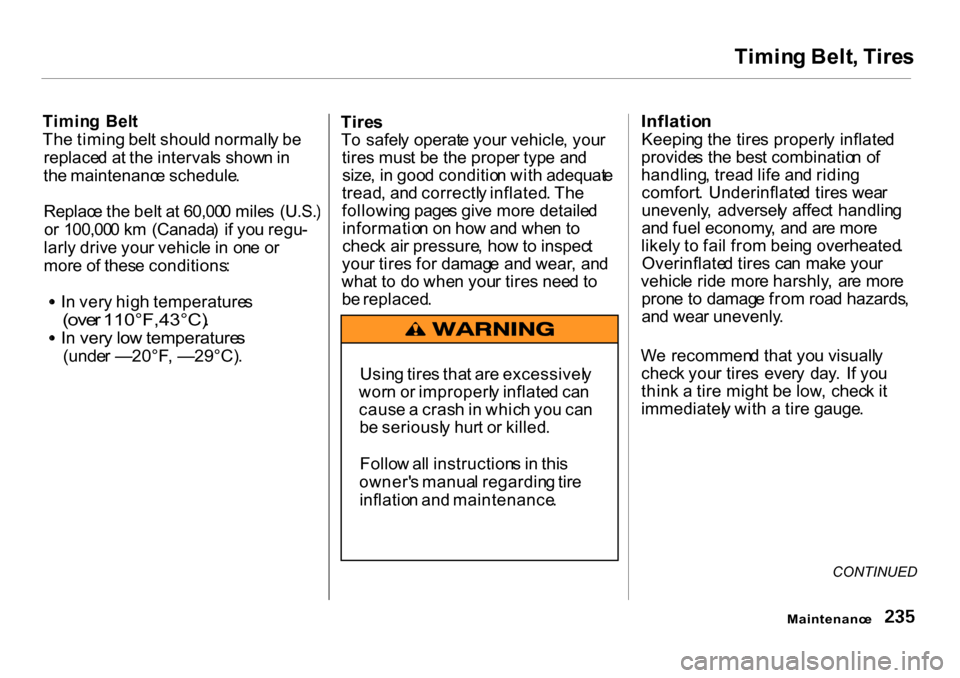
Timin
g Belt , Tire s
Timin g Bel t
Th e timin g bel t shoul d normall y b e
replace d a t th e interval s show n in
th e maintenanc e schedule .
Replac e th e bel t a t 60,00 0 mile s (U.S. )
o r 100,00 0 k m (Canada ) i f yo u regu -
larl y driv e you r vehicl e in on e o r
mor e o f thes e conditions :
I n ver y hig h temperature s
(ove r 110°F,43°C) .
I
n ver y lo w temperature s
(unde r — 20°F , — 29°C) .
Tire
s
T o safel y operat e you r vehicle , you r
tire s mus t b e th e prope r typ e an d
size , i n goo d conditio n wit h adequat e
tread , an d correctl y inflated . Th e
followin g page s giv e mor e detaile d
informatio n o n ho w an d whe n t o
chec k ai r pressure , ho w to inspec t
you r tire s fo r damag e an d wear , an d
wha t t o d o whe n you r tire s nee d t o
b e replaced .
Inflatio
n
Keepin g th e tire s properl y inflate d
provide s th e bes t combinatio n o f
handling , trea d lif e an d ridin g
comfort . Underinflate d tire s wea r
unevenly , adversel y affec t handlin g
an d fue l economy , an d ar e mor e
likel y t o fai l fro m bein g overheated .
Overinflate d tire s ca n mak e you r
vehicl e rid e mor e harshly , ar e mor e
pron e t o damag e fro m roa d hazards ,
an d wea r unevenly .
W e recommen d tha t yo u visuall y
chec k you r tire s ever y day . I f yo u
thin k a tir e migh t b e low , chec k i t
immediatel y wit h a tir e gauge .
CONTINUED
Maintenanc e
Usin
g tire s tha t ar e excessivel y
wor n o r improperl y inflate d ca n
caus e a cras h in whic h yo u ca n
b e seriousl y hur t o r killed .
Follo w al l instruction s in thi s
owner' s manua l regardin g tir e
inflatio n an d maintenance .
Page 240 of 326
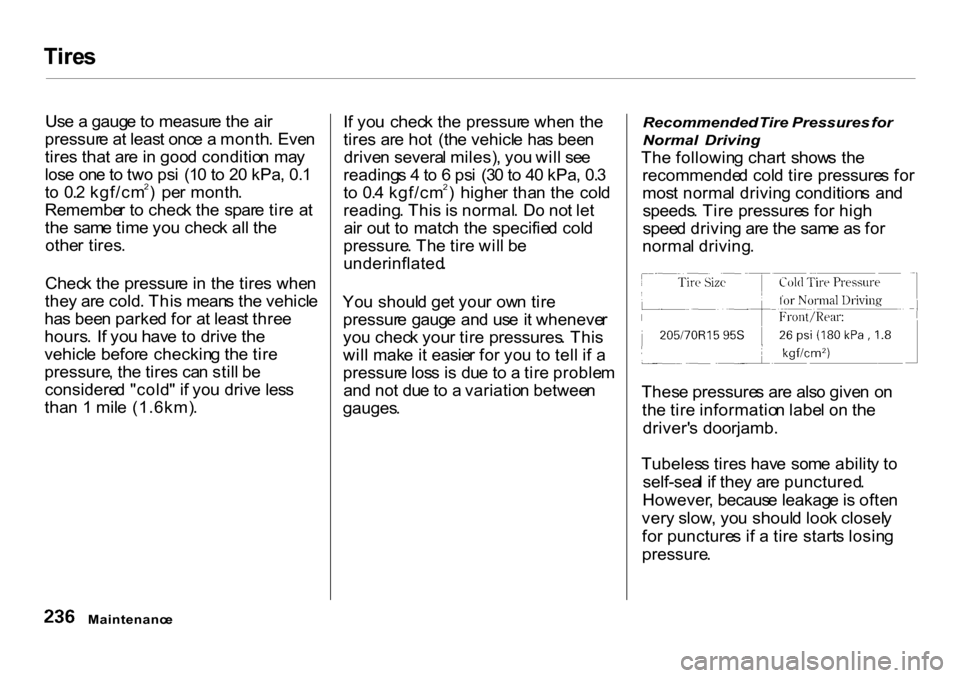
Tire
s
Us e a gaug e to measur e th e ai r
pressur e a t leas t onc e a month . Eve n
tire s tha t ar e in goo d conditio n ma y
los e on e to tw o ps i (1 0 to 2 0 kPa , 0. 1
t o 0. 2 kgf/cm 2) pe r month .
Remembe r t o chec k th e spar e tir e a t
th e sam e tim e yo u chec k al l th e
othe r tires .
Chec k th e pressur e in th e tire s whe n
the y ar e cold . Thi s mean s th e vehicl e
ha s bee n parke d fo r a t leas t thre e
hours . I f yo u hav e t o driv e th e
vehicl e befor e checkin g th e tir e
pressure , th e tire s ca n stil l b e
considere d "cold " i f yo u driv e les s
tha n 1 mil e (1.6km) . I
f yo u chec k th e pressur e whe n th e
tire s ar e ho t (th e vehicl e ha s bee n
drive n severa l miles) , yo u wil l se e
reading s 4 to 6 ps i (3 0 to 4 0 kPa , 0. 3
t o 0. 4 kgf/cm 2) highe r tha n th e col d
reading . Thi s i s normal . D o no t le t
ai r ou t t o matc h th e specifie d col d
pressure . Th e tir e wil l b e
underinflated .
Yo u shoul d ge t you r ow n tir e
pressur e gaug e an d us e it wheneve r
yo u chec k you r tir e pressures . Thi s
wil l mak e i t easie r fo r yo u t o tel l i f a
pressur e los s i s du e t o a tir e proble m
an d no t du e to a variatio n betwee n
gauges .
Recommended
Tire Pressures for
Normal Driving
Th e followin g char t show s th e
recommende d col d tir e pressure s fo r
mos t norma l drivin g condition s an d
speeds . Tir e pressure s fo r hig h
spee d drivin g ar e th e sam e a s fo r
norma l driving .
Thes e pressure s ar e als o give n o n
th e tir e informatio n labe l o n th e
driver' s doorjamb.
Tubeles s tire s hav e som e abilit y t o
self-sea l i f the y ar e punctured .
However , becaus e leakag e is ofte n
ver y slow , yo u shoul d loo k closel y
fo r puncture s i f a tir e start s losin g
pressure .
Maintenanc e